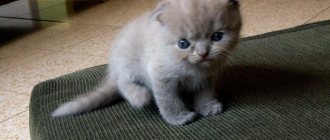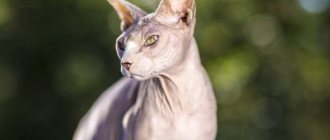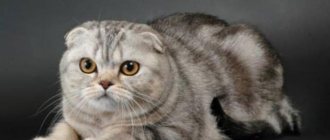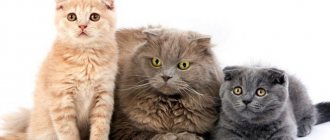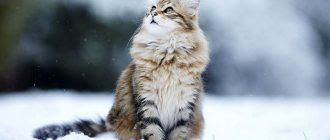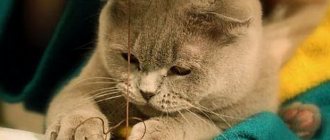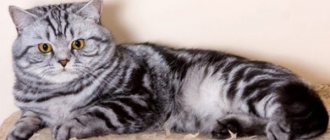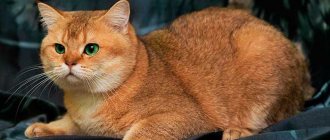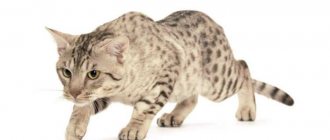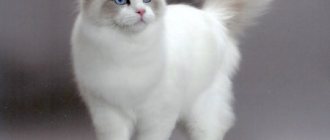Among pet lovers there are quite a lot of fans of Scottish Straight cats. The nature of the pets allows them to be kept in families with small children. However, the breed requires care and knowledge of the animal’s character. In order for your pet to feel good, you should take proper care of it. Scottish cats are a breed that appeared relatively recently, but in a short time the animals were able to win the hearts of both ordinary breeders and charm people specializing in breeding. At first glance, the appearance of the pets is ordinary, but there are quite unusual and exceptional features that attract many. Representatives of the Scots sometimes look formidable, sometimes strict, but at the same time they are always so sweet.
Some confusion
The Scottish Straight cat, the photo of which is presented in this article, is a close relative of the Scottish Straight. However, the characters of the animals are radically different. Often the habits of the latter cause bewilderment among breeders; they cannot be kept in a family with children due to excessive aggressiveness and intolerance even with small pranks.
The characteristics of Scottish straight-eared cats are radically different. They are completely different from their relatives. However, before purchasing them, it is necessary to find out the characteristics of the animal’s character and its standard habits, so that if difficulties arise in upbringing, you will be able to cope with them.
History of the origin of the Scottish Straight cat
global $ads_google;
//data-ad-slot=”2475549904″ $ads_google = empty($ads_google) ? false : true; ?> if ($ads_google == false) {?> $ads_google = true; ?> } ?> Today, Scottish Folds are considered more elite and valuable. Although without straights, folds would simply disappear. On the other hand, Scottish Straights are the same cats with drooping ears, whose hearing organs have retained an upright position by the age of one month. In general, the two types of these Scottish cats could not exist without each other. Therefore, the “chronicle” of the existence of the breed begins with the birth of the first fold-eared kitten named Susie.
In the early 60s of the last century, British felinologist William Ross discovered an amazing cat cub with forward-curved ears in one of the cities of Scotland. The breeder and his wife were fascinated by the white fluffy cat. A couple of British cat lovers immediately realized what potential was hidden in the unusual offspring born from a completely ordinary cat.
A few years later, Susie brought kittens to her owners, one of which inherited her mother’s exterior features. The young snow-white female was given the name Snook. Having resorted to the help of a geneticist, Ross began breeding Scottish Folds. During selection, it turned out that an autosomal dominant gene is responsible for the special structure of the hearing organs in cats. That is, this is a “sick” trait that is inherited, and this “detail” of appearance is more likely a flaw than a source of pride.
Despite this, William Ross continued the experiment. To breed Scottish pets, he mated them with British shorthair cats and ordinary domestic cats. The first year of work has already been very fruitful. A British felinologist managed to breed about 40 Scottish Folds and 30 Scottish Straights .
The ears of the fruits of genetic experiments were similar to those of rabbits, so at first the representatives of the breed were simply called lop-eared. Later, by 1966, they became known as folds. At the same time, wonderful cats were officially registered for the first time. However, soon experts began to worry that floppy ears could cause frequent infections and even deafness. The more pressing problem was the animal's unstable gene pool. For this reason, British organizations stopped the registration of the Scots, after which the cats went to conquer America.
In the states, scientists began to rehabilitate the breed and improve the set of genes. By 1973, the fluffy Scottish Sheep were approved by the CFA and ACA, and five years later they received championship status.
Description of the Scottish Straight cat
Scottish cats differ in a number of characteristic features that are unique to this breed. Sometimes animals are often confused with the British species, but during the comparison process the following differences can be identified:
- more rounded head;
- the body has an oblong and elongated shape, which gives the animal elegance;
- body proportions are slightly reduced;
- the average weight of a cat is 3 - 5 kg, boys weigh slightly more than females;
- pets are very flexible and remain hardy and playful at any age.
Genetics color point
The hairs and eyes of British Color Point kittens are filled with color due to melanin. Its production occurs under the influence of tyrosinase (enzyme) on the amino acid tyrosine. Tyrosinase works under the control of the C - color gene, which determines what shade the eyes and hairs will be. In the case of gene C mutation, the production of active tyrosinase is blocked, which prevents the appearance of pigment. In this situation, an albino animal with bleached fur will be born. A lowercase letter “c” is used to designate a mutant gene.
Photography – Genetics of color point color
Wool changes its color when exposed to different temperatures. The principle “the warmer, the brighter” works here. Thus, the color of the muzzle, ears, front and hind limbs, and tail is darker relative to the body. The cs gene is responsible for the manifestation of the Siamese coat coloring, allowing the pigment to penetrate the hairs only on parts of the body at a lower temperature.
Fun fact: Newborn Siamese kittens (British Color Point kittens) have a completely light coat color because the environment in the womb is warm. The final color will be established at the age of 6-10 months.
The recessiveness of the cs gene will allow it to appear in the offspring only if it is present in the genotype of both producers. To do this, producers do not have to be colorpointed; it is enough to be carriers of the gene.
Photo - Eye color
Straight-eared Scottish cat: character and habits
Inexperienced breeders often wonder how to determine in advance the future character of a kitten. It is well known that Scottish Straight babies show a special disposition already in the first months of life. As soon as the babies' eyes appear and they begin to crawl around the apartment, it becomes clear whether the cat will be balanced and obedient. Perhaps he will become a tireless and energetic researcher. Or perhaps the kitten will become a phlegmatic, calm cat.
Kittens of this breed, even born from the same mother cat, may be completely different in habits and character from each other. Sometimes it seems that it is impossible to determine which of the mischievous kids will be the optimal pet for a particular family.
General characteristics of the breed
At first they were confused - “British” and “Scots”. However, in appearance they are completely different: British cats (and especially male cats) are distinguished by strong bones and large bodies. The Scottish cat has a more open muzzle, no expressive cheeks, and the look of its large round eyes is not so stern. In general, "Scottish" cats do not look as heavy and powerful as British cats.
Appearance
According to breed standards, the Scottish Straight cat has:
- the body is medium-sized, shorter and not as squat as that of a British cat;
- a noticeably rounded head, gradually turning into a neck;
- convex, but with signs of rounding forehead;
- well developed chin;
- large expressive eyes;
- wide, oblong nose.
The Scottish Straight's limbs are medium in size, its tail is wide, slightly tapering towards the tip. Add to this the soft, feather-like fur that is pleasant to the touch. In straight-eared kittens, it can be either short or long.
The cuteness of the muzzle is given by a small “dimple” at the base of the nose, between the eyes. Because of this feature, the cat looks a little proud.
The main advantage of the Scottish Straight is its ears. Medium-sized or small, neat, they are located high on the head, spaced relative to each other, but ears that are too wide, like those of a British cat, are considered a breed defect. The tips of the ears are slightly set aside and slightly rounded.
"Scottish" cats have expressive eyes. They are wide open, and the look, especially in small kittens, seems surprised. The color of the iris depends on the color of the coat. Kittens are born with blue eyes, and only by four months can you understand what they will be like. Adult Scottish cats may have eyes that are:
- blue;
- green;
- golden;
- amber;
- copper;
- orange;
- brown.
For breeders, it may be important what color the animals will be, so it is not recommended to pick up kittens early, less than four months of age.
Breed standards allow for a variety of coat colors in Scottish Straight cats. A thick plush coat can be plain, marble, or tortoiseshell. Popular colors:
- black;
- chocolate;
- white;
- lilac;
- black smoke;
- tabby;
- marble on silver (“whiskas”).
The cost of a Scottish Straight kitten largely depends on the coat color. The rarest and most valuable color is lilac, the most popular is chinchilla, marble on gold or marble on silver.
Naughty family friend
Young Scots with a strong temperament are constantly trying to run away somewhere, hardly sit still and are actively exploring the world around them.
Inquisitive furry creatures sniff very carefully at unfamiliar smells, listen to any rustles, frolic with their brothers and sisters for a long time and always try to stir them up.
Playful animals show their hunting instincts at any convenient moment. Such kittens are either trying to catch their tail or hunting for shadows. But in any case, they are the only ones who initiate playful pursuits.
Balanced and calm family member
If you need to get a non-capricious and balanced kitten who will not constantly jump and regularly demand attention, you need to take a closer look at the babies who sit apart in the basket. Usually such kids do not participate in the fun of others, and if they are drawn into the game, then the kittens join in without much enthusiasm.
Balanced kids love to sleep and spend a lot of time alone. If they begin to explore the surrounding space, they do it alone.
There is even a pattern by which you can identify a calm, straight-eared Scottish cat. The character and habits of such a baby will be distinguished by calmness and balance in its external and internal manifestations. The kitten carefully touches various objects with its paw, does not strive to constantly be the center of attention and does not involve other pets in its explorations.
Such an animal gets very used to its owners and becomes a family favorite. Usually these cats are immersed in themselves and try to somewhat isolate themselves from others.
Weight table by month
The Scottish Straight weight gain graph is clearly demonstrated in the table by month.
| Age | Female (weight in kilograms) | Male |
| 1 month | 0.3-0.65 g | 0.45-0.75 g |
| 2 | 0.45-0.8 g | 0.8-1.6 |
| 3 | 1.25-1.7 | 1.3-2.4 |
| 4 | 1.7-2.35 | 2.1-3.8 |
| 5 | 2.25-3.1 | 2.45-4.2 |
| 6 | 2.3-3.5 | 3.1-5.5 |
| 8 | 2.9-4.3 | 3.4-6 |
| 10 | 3.1-4.6 | 4.2-7.2 |
| 1 year | 3.2-5.3 | 4.6-7.4 |
| 2 and older | 3.4-5.6 | 5.3-8.2 |
Factors influencing the habits of the Scots
Scottish straight-eared cats are gaining popularity among ordinary people and professional breeders due to their character and unusual appearance. Animals can react quite adequately to children's pranks, so their nature allows them to be kept in families with children.
The character, habits and habits of the breed can be influenced by various factors and life circumstances. Therefore, the characteristics of Scottish straight-eared cats can be directly related to the very upbringing of the kitten and the conditions of its keeping. The breeder needs to pay attention to:
- pet's habitat;
- his surroundings.
Habits can change greatly due to the presence of other animals in the house, as well as due to various medical procedures required for Scottish Straight cats. The character of a sterilized or neutered animal differs from that of the one that bears offspring. Let's consider the factors that most influence the breed's leashes next.
Care and maintenance
Scottish Straights are typical domestic cats for whom walks in the fresh air are pleasant entertainment, but not more than that. This is why Scots are considered ideal pets for homebodies. In everyday life, straights are unpretentious and rarely cause trouble. Take your animal for routine veterinary examinations, carry out timely vaccinations, use high-quality food - and straight-eared Scottish cats will not create any problems for you.
Hygiene
Scottish Straight loves his mistress
Scottish Straights are very clean cats that carefully monitor the condition of their own fur, but they still need to be bathed from time to time. Usually, cats are washed as their “coat” gets dirty, using shampoo from the pharmacy. At the end of the procedure, you can apply a balm to the coat. When bathing, make sure that water does not get into the animal’s ears and be sure to protect the wet pet from drafts.
Owners of show-class specimens preparing to participate in exhibitions will have to work a little harder. In particular, a few months before the event, the cat begins to be washed daily to completely remove dead cells from its skin and stimulate the growth of new fur. In addition, you will have to spend money on a variety of professional coat care products, ranging from degreasing paste to texturizing conditioner. Brush Scottish cats once a week with a short hair brush. Claws are trimmed as they grow. Be sure to monitor the condition of your cat's eyes and remove unwanted discharge with a swab soaked in hygiene lotion.
Feeding
The diet of Scottish Straights is no different from the “menu” of their fold-eared counterparts. Just like folds, Scottish straight-eared cats benefit from lean meat, offal, boiled sea fish, fermented milk products, and egg yolk. In addition, the animal’s diet should include vegetables (raw or stewed), cereals and sprouted wheat.
Prohibited
- Fat meat.
- Beans and potatoes.
- Bones.
- Sweets, spices, smoked foods.
- Garlic and onion.
- Bread.
- River fish.
- Citrus.
- Mushrooms.
- Raw eggs.
Curious Scottish Straight
In serious nurseries, Scottish Straight kittens are sold starting from the age of three months. During this period of life, the baby no longer feeds on mother's milk, which means it is able to eat the same food as an adult animal.
An important point: natural-fed straight cats do not receive enough of the vital microelements. Vitamin and mineral complexes, which can be purchased at a veterinary pharmacy, solve this problem.
Scottish Fold cats can also be fed commercial food if you are willing to spend money on its non-budget varieties - “premium”, “super premium” and “holistic”. An ideal cut for a Scottish dog should contain at least 26% protein and about 9% fat. It is advisable that the food does not contain wheat and corn, which can cause allergies in the cat. From this point of view, the most useful options for “drying” can be considered the Canadian Acana Pacifica Cat and the American Earthborn Holistic.
Three-month-old Scots are fed up to 6 times a day, six-month-old kittens eat 5 times a day, nine-month-old kittens - 4 times. One-year-old individuals are considered adults, so 2-3 meals are enough for them.
Surrounding area
Reviews about the habits of the Scottish straight-eared cat and the nature of his behavior confirm the fact that these are quite calm and balanced animals. Professional breeders say that pets can change significantly due to the human factor. For example, the presence of mischievous children in the house can have both a negative and a completely positive effect on a kitten.
If adults allow children to treat kittens roughly and cruelly, not realizing that pets are vulnerable and weak, then as they grow up, the animals may become withdrawn, angry and suspicious. Cases have been recorded when pets began to take revenge on their owners. If children and adults approach the cat with affection and are kind to it, then the animal grows up calm and, depending on its disposition, mischievous or peaceful.
Sterilization
This procedure is often applied to Scottish Straights, so its effect on the disposition of its charges is known - males, like females, receive peace. Pets do not turn into sluggish and lazy at all. See at what age cats are sterilized.
The enthusiasm does not disappear, and more obedience and peacefulness appear. In addition, animals deprived of the instinct to procreate have better health and more energy.
Location
Place of residence and living conditions have a great influence on the formation of the character of the Scottish Straight cat. The character of the animal greatly depends on these circumstances. It is known that without proper care, animals have difficulty adapting to their environment and become angry, aggressive and withdrawn. However, the breed is very self-sufficient. A cat needs its own private corner where it can feel comfortable and relax.
Scots are very attached to home and family members. Relocation has a serious impact on them. Such changes in life can turn a self-confident animal, affectionate and playful, into a cowardly and embittered one.
Reviews about the character of the Scottish Straight cat indicate that he can live quite comfortably in the courtyard of a private house. Animals are excellent catchers and getters. They often defend their possessions from rodents, birds and other creatures and also obtain their own food.
If a Scotsman lives in an apartment, then the kitten grows up less active and independent. However, reviews indicate that in this case the animal is more attached to the person and shows its affection more actively.
Such pets love to sleep on the laps of household members and play gambling with children, if they are not cruel. Also, the Scots are quite peaceful with other pets. But, according to reviews from most breeders, Scottish Straight cats are very picky when it comes to nutrition.
Main character traits of an adult cat
What should you expect from an adult in most cases?
- Importance - despite the fact that Scottish dogs, like people, are completely different, for the most part they are calm in appearance. They are suitable for definitions of sedateness and some imposingness. The sense of self-esteem in such cats is unusually developed. They will consider leprosy beneath their status. As well as the opportunity to impose. Of course, there are overly sociable pets, but this is rather an exception to the rule.
- Ingenuity is the result of their insatiable curiosity and observation. In most cases, Scottish dogs are able to accept criticism from the owner and understand what exactly he wants. However, this does not mean at all that the cat will follow the lead. The only way for the owner to win is to convince the pet that he will benefit.
- Sensitivity - despite a certain amount of independence, good nature and non-conflict, Scottish dogs are always ready to rush to the rescue. And both the owner and the mustachioed housemate. If the cat considers that his help is necessary, she will not keep her waiting. However, force majeure is not necessary to show the sensitivity of a Scot. It is enough for the owner to simply be in a bad mood - the cat will be right there with the intention of cheering up the person. When irritated, the picture is different - the mustachioed companion will try not to cause unnecessary irritation and will quietly go about his important cat business.
- Curiosity - this has already been stated, but one more nuance can be added. Often a Scot is interested in what his owner is interested in. Whether it's taking a bath or cooking, the animal will want company.
Presence of other animals in the family
Scottish Straights often look down on other pets. However, if they were brought up with such people from childhood, then such an attitude does not arise. When a kitten ends up in a home inhabited by other animals, the owners can rest assured of a positive outcome. The baby will definitely get along not only with his relatives, but also with birds, tame rodents and even dogs.
The character of the Scottish straight-eared cat, who grew up in the same house with dogs, is distinguished by mischief and cheerfulness. These animals are cheerful, agile and very attached to their owner.
But living in the same house with felines, the Scots can become overly jealous. In this case, they become attached to cats more than to members of the household and the owner.
Kitten selection criteria
You should choose a kitten taking into account the breed standards. All small kittens of the Scottish breed have straight ears, and what they will be like will become clear in a few months. You shouldn’t take a kitten to a new home too early: with mother’s milk, kittens receive the necessary nutrients that strengthen their immune system.
In order for the offspring to be healthy, breeding rules must be followed. And if you were told that the kitten’s father is a “purebred British” and his mother is a “Scottish” fold, the kitten is unlikely to grow up healthy. Mating a Scottish cat is only possible with a representative of the same breed - a “Scottish cat”. Alas, there are often unfortunate breeders who think only about profit and not about the health of the animals.
Leisure influencing character
The character of Scottish straight-eared male cats is somewhat different from girls. Males more often show their hunting skills, strive to get their own food and show strength in the process of protecting themselves. Females are more affectionate and playful, but if they have offspring, they can show aggression.
In order for a kitten to develop harmoniously, it needs a variety of toys. If there are a lot of them, then the pet is unlikely to turn into a glutton, a calm phlegmatic person or a lump. Such a Scot will be characterized by agility, energy and a desire to hunt.
Tray training a kitten
Toilet training a Scottish cat requires especially a lot of patience from new owners if the kitten has not been accustomed by the breeders to a specific litter and taught the basic rules of personal hygiene. Caring for a Scottish cat will necessarily include timely replacement of the litter, since Scottish cats are very clean and may completely refuse to visit the litter box if it is not cleaned on time and proper care is provided.
If your kitten goes to the toilet in the wrong place, you should not scold him, since the character of the Scottish cat is quite stubborn and she will regard this not as a lesson and basic care, but as direct aggression.
Proper care will include the gentle upbringing of a Scottish cat, in which case the cat will grow up docile and will not shit in inappropriate places, either intentionally or accidentally.
The Scot as a true friend
Many people want to get a representative of this breed because the animals are obedient. For your pet to understand that they are angry with him, it is enough to change his intonation. Reviews from breeders show that it is quite easy to train small kittens to use a tray. If necessary, they can relieve their needs in the courtyard of a private house. Scottish Straight cats quickly learn what is permissible to do in the house and what will be punished. Many Scottish owners say that it is not scary to leave such a pet at home alone, because it does not harm property. Often breeders find an animal in the same place where it lay before they left.
However, this does not mean that the animal is inactive. Scottish Straight cats are very inquisitive and playful. Animals often do not know how to stop when participating in games, so it is worth limiting pets in their natural instincts and not allowing them to scratch themselves or household things.
How to feed
You need to know that feeding representatives of this breed with packaged food should be accompanied by their advance soaking with water, milk or curdled milk. In addition, for the first time after the baby is delivered from the nursery, he should be treated as he was fed there.
If there is a sudden change in feeding schedule, or if new food is immediately offered, the kitten may experience indigestion. It is better to avoid such troubles for your pet in every possible way.
Conscientious nurseries give the new owner a package of food and pellets for the tray. This allows the kitten to get used to a completely new environment more easily and in a shorter period of time.
Scottish Straight babies and adults require dairy products. So it would be good to treat them with milk, yogurt and cottage cheese from time to time. It is not recommended to offer cream with sour cream; it is hard on the cat’s liver.
Natural foods suitable for this breed:
- liver and heart;
- lean beef and chicken;
- dairy products;
- herbal ingredients;
- a little vegetable oil, they need to be seasoned with stewed and boiled vegetables before serving.
It should be remembered that Scottish Straights require moderate nutrition! In no case should you give too much, no matter how many months or years old they are, in order to avoid excess weight and poor health in your pets (see table of Scottish kitten weight by month). Thoroughbred animals should have medium size and smooth outlines.
